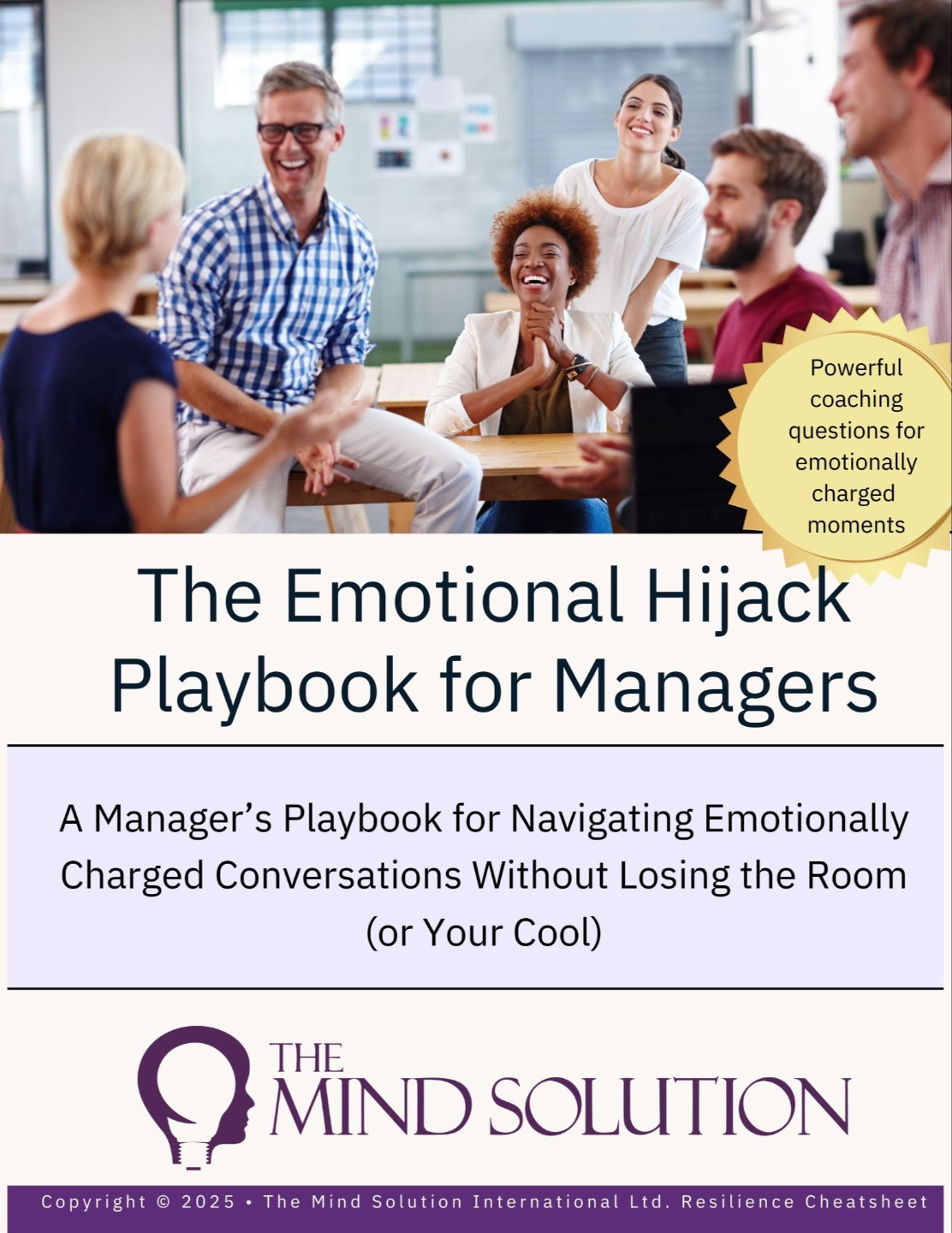How to Help Employees Overcome Anxiety at Work
Aug 06, 2025
Overcoming Anxiety at Work: How to Support Employees to Thrive (Not Just Survive)
This might sound odd, but I love training people in the workplace on the subject of anxiety. As someone who has also been a therapist for over a decade and worked deeply with anxiety more than anything else, I’ve seen firsthand how transformative clarity and practical tools can be.
So, before I give you the lowdown on how to help support your employees to overcome anxiety, let’s start by understanding what anxiety is.
What Is Anxiety and How Does It Show Up at Work?
You might have encountered anxiety in many forms:
- generalised anxiety
- social anxiety
- fears
- phobias
- trauma, including PTSD or complex PTSD, or
- specific anxieties like a fear of public speaking.
What I’ve observed over the years is that anxiety often doesn’t stem from the external event; it’s held alive by the beliefs people have about it.
Many believe anxiety is something they must learn to live with, that it’s part of their personality, or that it’s inherited. I aim to blast all of those limiting beliefs out of the window.
By helping people understand the “inside the mind” functioning, how thought is created, how habitual thinking conditions us, and how over 90% of our thinking is conditioned and automatic, they begin to see anxiety for what it truly is: a learned pattern, not a fixed identity.
How Big Is the Anxiety Problem at Work?
Anxiety disorders are one of the most common mental health conditions globally. Nearly 18% of adults in the U.S. experience an anxiety disorder each year Wikipedia, and around 1 in 13 people worldwide are affected by anxiety Wikipedia.
In the workplace, statistics are telling:
-
Around 14.7% of employees experience mental health problems at work, including anxiety Wikipedia+15Spill+15WebMD Health Services+15.
-
Globally, 12 billion working days are lost each year to depression and anxiety—costing around US $1 trillion per annum in lost productivity World Health Organization+2World Health Organization+2.
-
In the U.S., 76% of workers reported at least one symptom of a mental health condition, and 84% said their workplace contributed to that condition HHS.gov+1.
-
Half of American workers report moderate to severe levels of burnout, depression, or anxiety mindsharepartners.
-
More than three in five UK employees experience moderate to severe depression and anxiety at work, with serious impacts on performance Workplace Options+1.
These figures show that anxiety in the workplace isn’t rare—it’s pervasive and costly.
What Are the Consequences of Anxiety at Work?
Employees with anxiety often report:
-
Strained relationships: 73% avoid social situations, 53% become short-tempered, and 43% avoid meetings ADAA.
-
Frequent triggers from work responsibilities: 53% cited deadlines, 46% interpersonal issues, 37% changes to job context, and 35% team dynamics NAMI+14ADAA+14APA+14.
And far from being discreet, the ripple effects impact attendance, productivity, staff engagement and retention.
What Do Employees Say They Want When They Are Anxious?
Ask someone with anxiety what they want, and usually they say: peace of mind, calm, and safety in their body. In our Employee Wellbeing webinars, we emphasise that those feelings already exist within us as our natural state. What takes us away from them is conditioned thought, and conditioning in the nervous system.
Helping employees understand this shift from conditioned anxiety back toward natural peace is empowering.
How Can Understanding Thought and Conditioning Reduce Anxiety?
When people realise that anxious thoughts are conditioned and not reflective of who they are or what’s certain about the future, it starts to shift their experience.
One of my favourite quotes from Dr Joe Dispenza: “You can’t see the label when you’re inside the jar.” People who've lived in anxiety for years often feel it's part of their identity, their “my anxiety.” But recognising that it's a conditioned pattern, not a permanent identity, gives them hope and space to change.
How Do Somatic Techniques Like EFT Tapping Help Employees Regulate Anxiety?
In our anxiety webinars, we introduce somatic practices like EFT tapping or havening that support physiological regulation. EFT tapping is simple, powerful, and can reduce cortisol levels within minutes. Its efficacy has been validated in scientific studies by Dr Peter Stapleton in Australia.
What's crucial is that talk-based therapies like CBT may fall short when the body’s alarm system is active. You cannot reason your way out of anxious feelings, especially when the autonomic nervous system is triggered. Somatic work allows immediate access to calming the system.
What’s the Role of Trauma and Micro-Trauma in Workplace Anxiety?
Many people associate trauma only with major life events, but in reality, micro-traumas happen daily. A harsh interaction in a meeting, workplace bullying, chronic job stress or poor culture all can lodge trauma memories in the nervous system.
In our treating trauma program, clients don’t need to speak about their trauma, nor even turn on their camera. In pilot sessions, over 50% of participants rated their trauma response on a 0–10 scale and reached 0 by the end of the session. That’s transformational relief.
Processing via the unconscious mind helps release stuck energy, old beliefs, and restores calm without traditional talk therapy.
How Can Employers Design Anxiety Support That Works?
Here’s how employers can bring workplace anxiety training to life:
-
Define clear goals: Are you aiming to reduce absenteeism, improve engagement, increase psychological safety, or improve help-seeking behaviour?
-
Understand your people’s beliefs: Ask employees what they think anxiety is, and shape training accordingly.
-
Start with foundational webinars like Inside the Mind: Introduce people to how thought, feeling, and conditioning work.
-
Follow up with practice-based sessions: Use EFT tapping or somatic tools so employees feel the shift—not just understand it intellectually.
-
Integrate treatment of trauma where needed: Make trauma-informed approaches accessible without retraumatizing or forcing disclosure.
-
Embed learning in norms and interactions: Encourage managers to role‑model vulnerability: “I’m feeling anxious this week,” or “I’m not OK right now.”
What Do Managers Need to Know When Supporting Anxious Employees?
Managers aren’t therapists, but they can do a lot to support an employee with anxiety:
-
Understand what to say—and importantly, what not to say.
-
Recognise underlying triggers—workload, changes, interpersonal stress.
-
Know the basics of relevant legal frameworks like the Equality Act or ADA.
-
Use listening and solution-focused coaching skills—not problem-solving fixation.
-
Maintain psychological safety: normalise talking about anxiety, encourage time‑out, model self-awareness.
Why Is Stigma Still Hindering Anxiety Support at Work?
Stigma remains a huge barrier. Surveys find:
-
Globally, depression and anxiety contribute to ~$1 trillion in lost productivity annually Teen Vogue.
-
In the UK, 85% of workers feel stigma still surrounds mental health at work; 58% don’t feel comfortable talking to their manager about it Teen Vogue.
-
In the U.S., 42% worry their career would be negatively impacted if they disclosed mental health struggles; just 13% told their manager they were suffering in the past year NAMI.
We must dismantle stigma so people feel safe to ask for help—before they reach crisis.
What Happens if You Wait Too Long to Act?
Many employees wait far too long before seeking help—often until burnout or a serious mental health breakdown. That’s not good for them, and it’s not good for your organisation.
Anxiety left unaddressed can cause chronic absenteeism, disengagement, performance dips, and eventual attrition.
What's the First Step Toward Supporting Anxiety at Work?
If you're thinking Yes—we need this for your organisation, here’s your first step:
Book a Discovery Call. We’ll talk through your specific situation, workforce needs, and how to build a sustainable, repeatable, anxiety-supportive programme—for both employees and their managers.
This isn’t just an informational webinar—it’s about starting a shift so anxiety stops shaping what people do and start shaping what they can become.
The Emotional Hijack Playbook For Managers
A Manager’s Free Resource for Navigating Emotionally Charged Conversations Without Losing the Room (or Your Cool).
Perfect to use in your next one-to-one.







